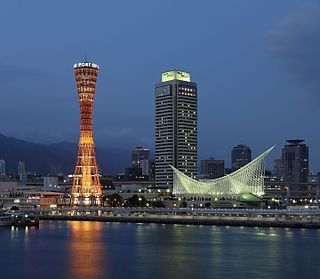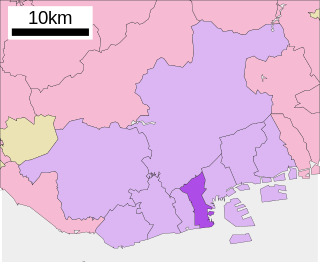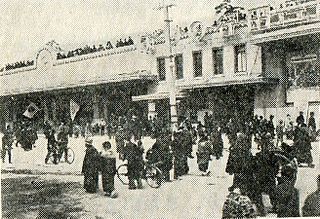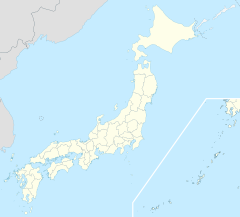
Kobe is the capital city of Hyōgo Prefecture, Japan. With a population around 1.5 million, Kobe is Japan's seventh-largest city and the third-largest port city after Tokyo and Yokohama. It is located in the Kansai region, which makes up the southern side of the main island of Honshū, on the north shore of Osaka Bay. It is part of the Keihanshin metropolitan area along with Osaka and Kyoto. The Kobe city centre is located about 35 km (22 mi) west of Osaka and 70 km (43 mi) southwest of Kyoto.

The Kobe Electric Railway Co., Ltd., often called Shintetsu (神鉄), is a Japanese private railway company in Kobe and surrounding cities. It is a subsidiary of Hankyu Hanshin Toho Group.

Shimamoto is a town consisting of the entirety of Mishima District, Osaka Prefecture, Japan. As of October 2016, the town has an estimated population of 29,970 and a density of 1,800 inhabitants per square kilometre (4,700/sq mi). The total area is 16.78 km2 (6.48 sq mi). It is located in Prefectural border with Kyoto Otokuni-gun Oyamazaki-cho. At the place where Katsura River, Uji River, Kizu River merge in the Yamazaki Gorge and become Yodo River It has prospered for a long time as a key point of transportation from Kyoto Basin to Osaka Plain. Recently, residential area development is progressing as Bedtown of Osaka City and Kyoto City.

Kusunoki Masashige was a Japanese samurai of the Kamakura period remembered as the ideal loyal samurai.

The Battle of Minatogawa, also known as the Battle of Minato River, was part of the Nanboku-chō Wars fought near the Minato River in Settsu Province on 5 July 1336.

The traditional lighting equipment of Japan includes the andon (行灯), the bonbori (雪洞), the chōchin (提灯), and the tōrō (灯篭).

Hyogo is one of nine wards of Kobe, Japan. It has an area of 14.56 km2 and a population of 106,322.

Miki Station is a passenger railway station located in the city of Miki, Hyōgo Prefecture, Japan, operated by the private Kobe Electric Railway (Shintetsu). There was a station with the same name on the Miki Railway Miki Line which ended operation on March 31, 2008, and abandoned the next day.

Kizu Station is a passenger railway station located in Nishi-ku, Kobe, Hyōgo Prefecture, Japan, operated by the private Kobe Electric Railway (Shintetsu).

Minatogawa Station is a railway station operated by Kobe Electric Railway Co., Ltd. in Hyogo-ku, Kobe, Hyōgo Prefecture, Japan.

Minatogawa-Kōen Station is a railway station in Hyōgo-ku, Kobe, Hyōgo Prefecture, Japan.

Harborland Station is a train station on the Kobe Municipal Subway Kaigan Line in Chūō-ku, Kobe, Hyōgo Prefecture, Japan.

Minatogawa College is a private junior college in Sanda, Hyōgo, Japan, established in 1952.
The Minatogawa man or Minatogawa specimens are the prehistoric population of Okinawa, Japan, represented by four skeletons, two male and two female, and some isolated bones dated between 20,000 and 22,000 years BCE. They are among the oldest skeletons of hominins yet discovered in Japan.
The Yamashita Cave People are the prehistoric humans known from many bones found in the Yamashita limestone cave located on the grounds of the Yamashita First Cave Site Park in Naha, Okinawa, Japan. The remains have been dated at 32,000±1000 years ago. The most important bones found in the cave in Yamashita are those of an approximately 6 to 8-year-old girl.
The Pinza-Abu Cave Man is a prehistoric people known from bones found in the Pinza-Abu Cave, near Ueno in Miyako Island, southern Japan. The remains appear to have the modern man anatomical type and have been dated to about 30,000 years ago, i.e. 25,800 ± 900 and 26,800 ± 1,300 before present. The name "Pinza-Abu" literally means "goat cave" in the local Miyakoan language.
Shiraho Saonetabaru Cave Ruins is a paleoanthropological site located on Ishigaki Island of the Yaeyama Islands in Japan. Shiraho Saonetabaru is a limestone cave.

Nawa Nagatoshi (名和長年) was a Kamakura Period military figure who defended the Southern Court during the Nanboku-chō period.

Japanese numismatic charms, also known as Japanese amulets, Japanese talismans, or simply Japanese charms, refer to a family of cash coin-like and other numismatic inspired types of charms that like the Korean and Vietnamese variants are derived from Chinese numismatic charms, but have evolved around the customs of the Japanese culture. Although most of these charms resemble Japanese cash coins and the amulet coins of China, they contain their own categories unique to Japan. In the case of these coins, "charm" in this context is a catchall term for coin-shaped items which were not official money. However, these numismatic objects were not all necessarily considered "magical" or "lucky", as some of these Chinese numismatic charms can be used as "mnemonic coins".
Kusunoki Masasue was a samurai warlord during the Nanboku-chō period, and the younger brother of Kusunoki Masashige. He died alongside his brother as part of the Battle of Minatogawa on July 5, 1336. He is famous for his last words Shichishō Hōkoku!.
















